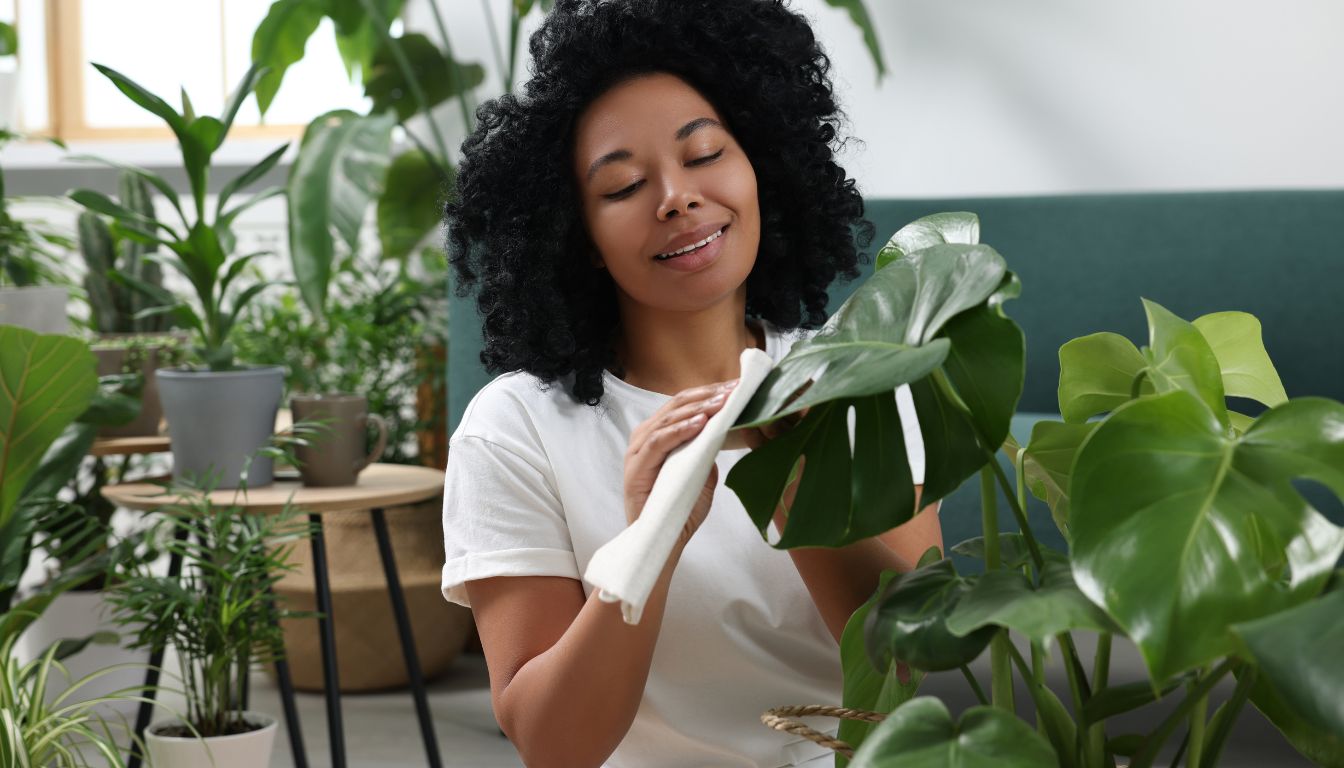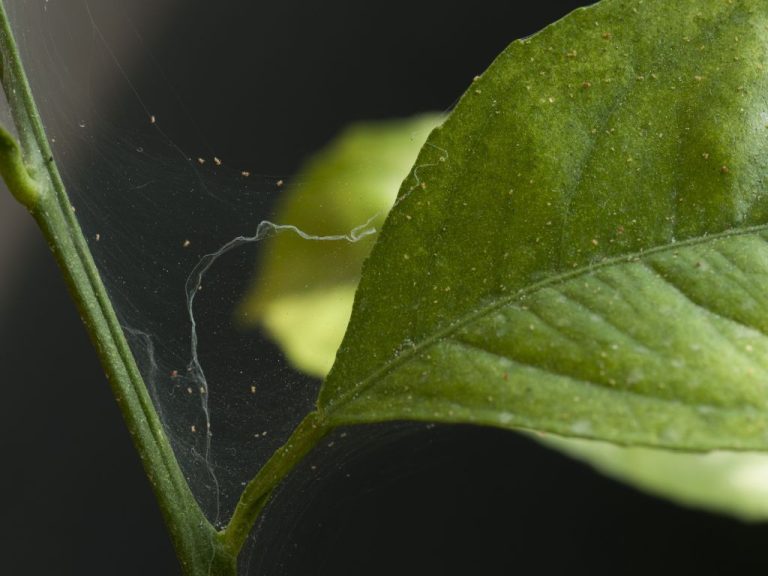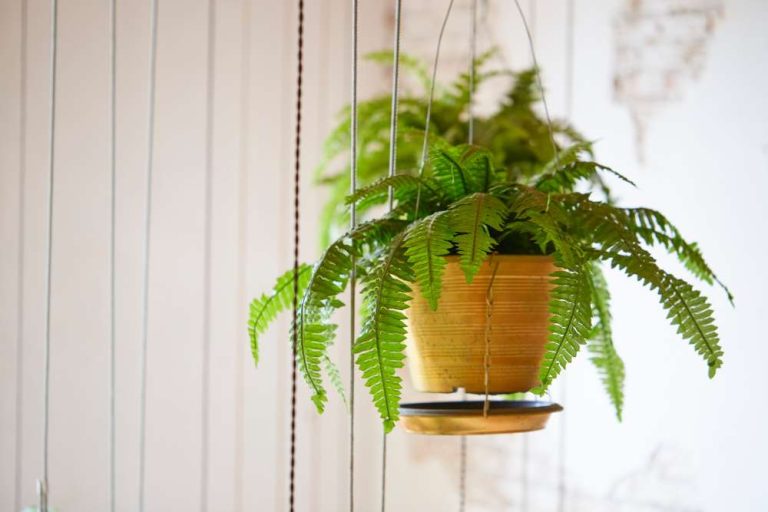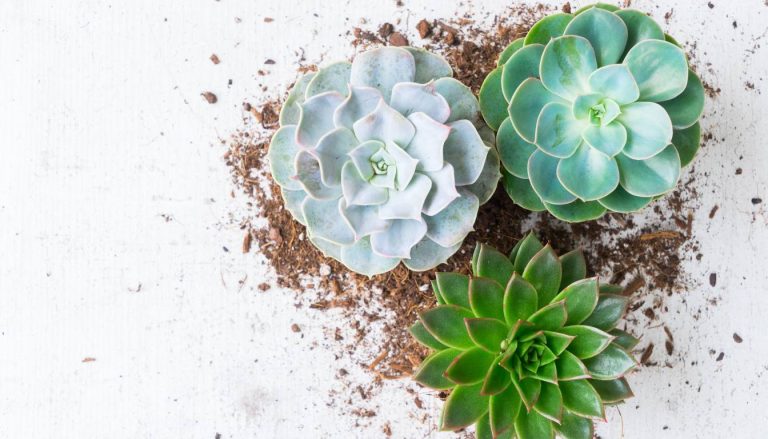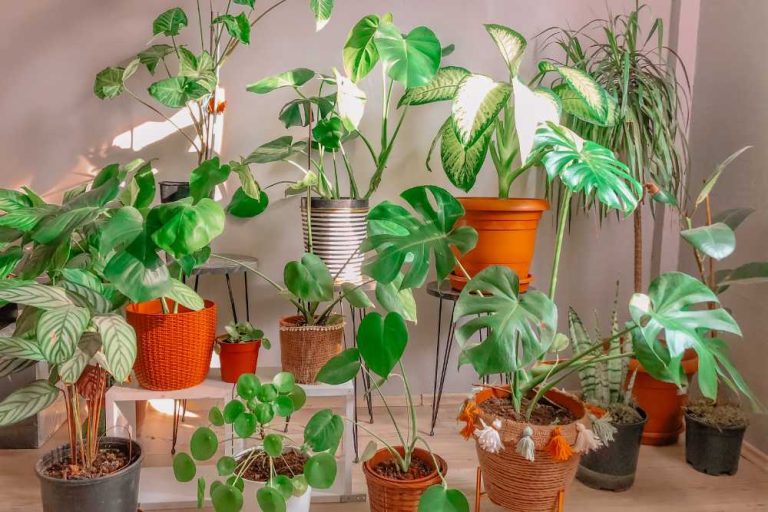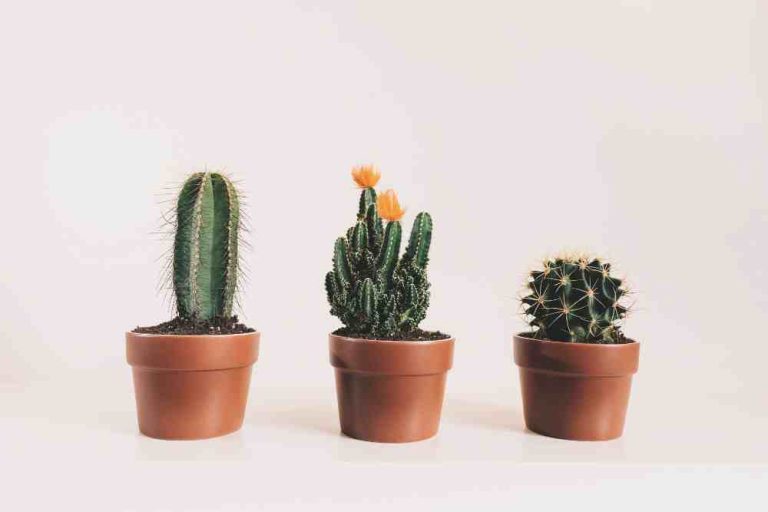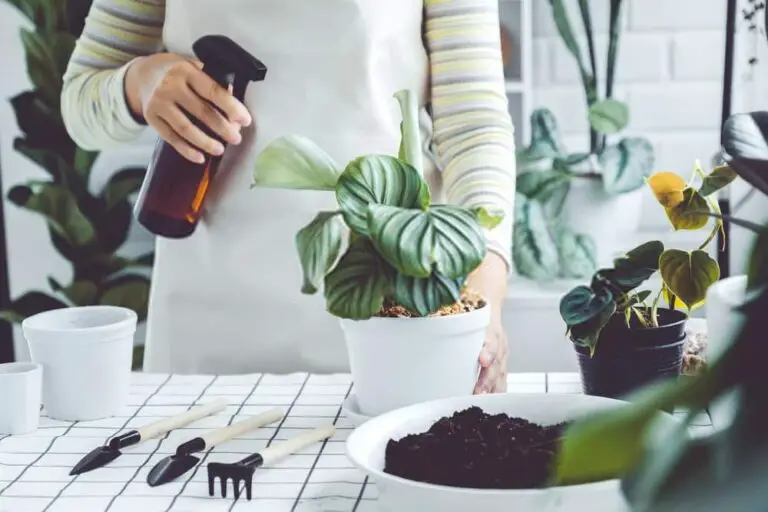Ultimate Guide to Tropical Foliage Indoor Plant Care: Harnessing the Beauty of Nature
Tropical house plants, such as Dieffenbachia, Bromeliads, Philodendron, Ficus, Alocasia, Anthurium, Schefflera, Monstera, Croton, and Pothos, can bring a burst of color and exotic charm to any home. Unlock the secrets to tropical foliage indoor plant care! I’ll guide you through the best tips to help your plants thrive in any US home environment.
These plants are renowned for their large, striking, and variegated leaves. Dieffenbachia, also known as Dumb Cane, showcases marbled green, white, and yellow leaves. Bromeliads come in various colors and textures, making them easy to cultivate.
With over 500 species, Philodendron provides an array of choices in vine and non-climber varieties. Ficus plants boast glossy leaves that make a statement in any room. Alocasia is a unique tropical house plant that requires extra care. Anthurium plants exhibit beautiful flowers or ornamental leaves. Schefflera, or umbrella plants, are popular and low-maintenance.
Monstera, with its distinctive Swiss cheese plant leaves, has become a favorite among plant enthusiasts. Croton plants present a variety of leaf shapes and colors. Pothos, on the other hand, is an easy-to-care-for starter plant for beginners.
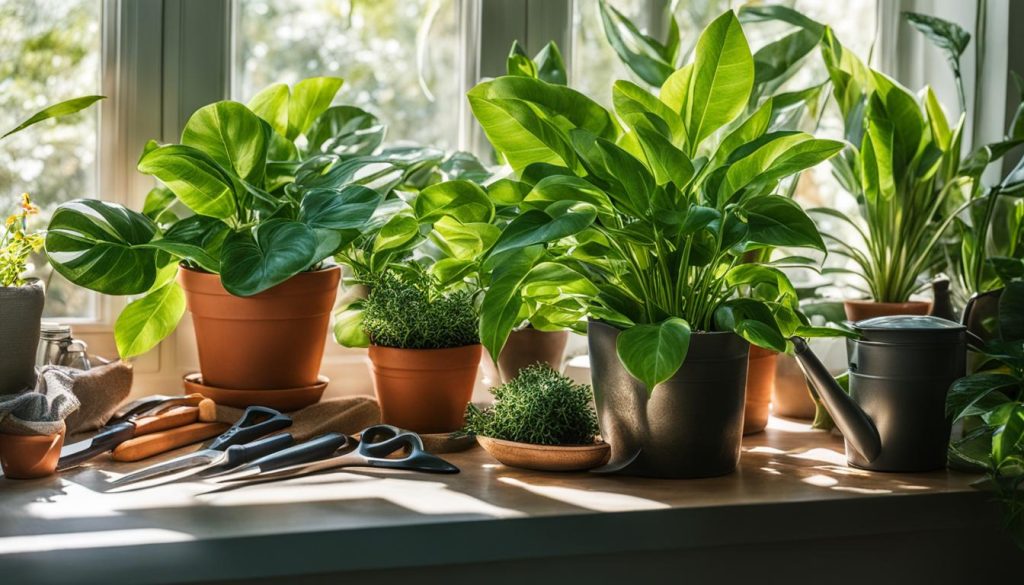
- Embrace the beauty of tropical foliage and indoor plants for a vibrant and exotic home.
- Choose from a variety of tropical house plants like Dieffenbachia, Bromeliads, Philodendron, Ficus, Alocasia, Anthurium, Schefflera, Monstera, Croton, and Pothos.
- Each tropical plant has specific care requirements, such as preferred light levels, watering needs, and humidity preferences.
- Ensure your tropical house plants thrive in temperatures suitable for their growth, ranging from 13℃ to 32℃.
- Croton and Pothos are easy-to-care-for options, great for beginners.
Dieffenbachia (Dumb Cane) Care Tips
Dieffenbachia, commonly known as Dumb Cane, is a tropical house plant that can add a touch of exotic beauty to any indoor space. Featuring unique variegated leaves in shades of green, white, and yellow, Dieffenbachia is a popular choice among plant enthusiasts.
To ensure the health and longevity of your Dieffenbachia plant, there are a few key care tips to keep in mind. First, it’s important to place your plant in an area with indirect, bright light. Avoid exposing it to direct sunlight, as this can scorch the leaves. Additionally, make sure to water your Dieffenbachia thoroughly, allowing the soil to dry out between waterings. Overwatering can lead to root rot, so it’s crucial to strike the right balance.
Dieffenbachia thrives in temperatures between 16℃ and 27℃, preferring warm and humid conditions. To create a suitable environment, you can mist the leaves occasionally or place a tray of water near the plant to increase the humidity level. Regularly check the soil’s moisture level by inserting your finger about an inch deep into the soil. If it feels dry, it’s time to water your Dieffenbachia.
Dieffenbachia Care Summary
| Light | Watering | Humidity | Temperature |
|---|---|---|---|
| Indirect, bright light | Allow soil to dry between waterings | Medium to low humidity | 16℃ to 27℃ |
Bromeliad Care Tips
As a tropical house plant enthusiast, I am always on the lookout for beautiful and low-maintenance plants to add to my collection. One such plant that has caught my attention is the bromeliad. With its vibrant colors and unique foliage, the bromeliad is a stunning addition to any indoor space. In this section, I will share some essential care tips to help you master the art of bromeliad care.
When it comes to light requirements, bromeliads prefer bright, indirect light. They thrive in a spot that receives plenty of natural light but is not directly exposed to the sun’s harsh rays. Placing your bromeliad near a window with sheer curtains or in a well-lit room can provide the perfect lighting conditions for its growth.
In terms of watering, bromeliads have a unique way of absorbing water. They have specialized leaves that form a cup-like structure, known as the “tank.” This tank collects and stores water, providing the plant with a source of hydration. To water your bromeliad, pour water directly into the tank, ensuring it is always filled. It’s crucial not to water the soil excessively, as this may cause root rot. Instead, focus on keeping the central tank filled with clean, non-chlorinated water.
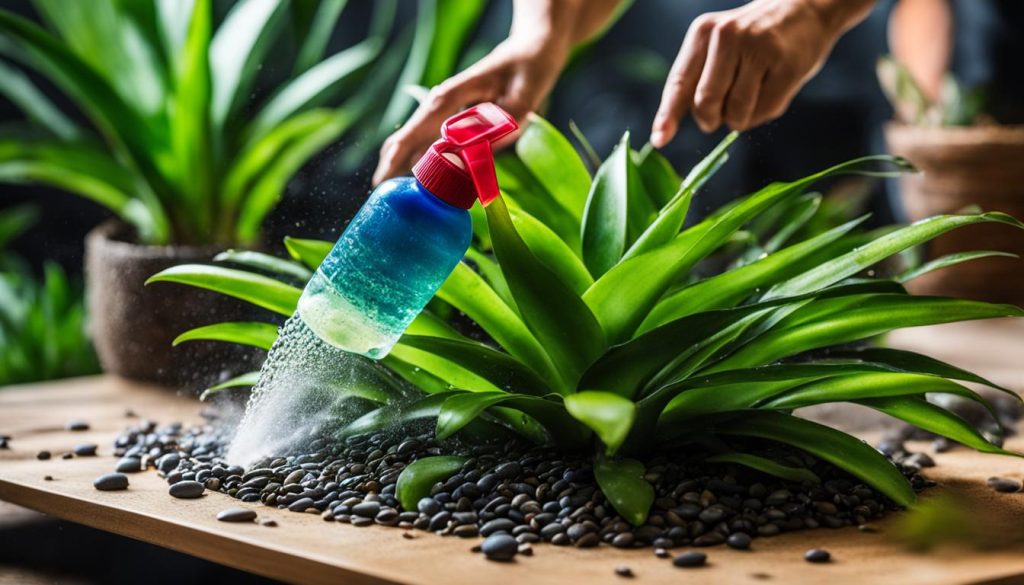
Fertilizing and Humidity
To keep your bromeliad healthy and thriving, it is essential to provide it with the right nutrients. Use a balanced, water-soluble fertilizer and apply it to the central tank or the soil surrounding the plant. However, be cautious not to over-fertilize, as it can lead to burning the roots. Following the manufacturer’s instructions for the fertilizer is crucial to prevent any damage to your bromeliad.
Bromeliads are native to tropical regions and thrive in high-humidity environments. You can increase the humidity levels around your bromeliad by misting it regularly or placing a tray filled with water near the plant.
This will create a micro-climate that mimics its natural habitat. However, avoid misting directly onto the leaves, as it may cause rot or fungal diseases. Instead, mist the surrounding air or use a humidifier to maintain optimal humidity levels.
Read – Humidity Tray For Indoor Plants
Summary Table: Bromeliad Care Tips
| Care Aspect | Tips |
|---|---|
| Light | Provide bright, indirect light |
| Watering | Fill the central tank with non-chlorinated water; avoid overwatering the soil |
| Fertilizing | Use a balanced, water-soluble fertilizer according to the manufacturer’s instructions |
| Humidity | Ensure high humidity levels by misting or using a humidifier |
Philodendron Care Tips
I am here to share some essential care tips for Philodendron plants, a popular choice among tropical house plant enthusiasts. Philodendrons are known for their diverse range of species and are cherished for their beautiful foliage. Whether you have a vine or non-climber variety, these tips will help you ensure your Philodendron thrives in your home.
Light and Placement
Philodendrons prefer dappled, bright light to mimic the natural light conditions found under a tropical canopy. It is best to place your Philodendron in a location with indirect sunlight, away from direct sunlight that can scorch its leaves. Consider placing it near a north-facing window or using sheer curtains to filter the light.
Watering and Humidity
Keeping your Philodendron lightly moist at all times is crucial for its well-being. However, avoid overwatering, as it can lead to root rot and other issues. Allow the top inch of soil to dry out before watering again. Philodendrons appreciate higher humidity levels, so misting the leaves occasionally or placing a humidifier nearby can help create a favorable environment for your plant.
Temperature
Philodendrons thrive in temperatures above 13℃. They prefer warm conditions and can suffer if exposed to cold drafts or sudden temperature drops. Aim to keep your Philodendron in a room with a stable temperature range and avoid placing it near windows or doors prone to drafts.
Fertilizing
While Philodendrons are generally low-maintenance plants, they can benefit from occasional fertilization during the growing season (spring and summer). Choose a balanced, water-soluble fertilizer and follow the instructions on the packaging for the correct dosage and frequency. Fertilizing once every two to four weeks should be sufficient to promote healthy growth.
Pest Control
Like many house plants, Philodendrons can be susceptible to pests such as scale insects, mealybugs, and spider mites. Regularly inspect your plant for any signs of pests and take appropriate action to prevent their spread. Use organic or commercially available pest control methods and ensure to follow the instructions carefully.
Philodendron Care Summary
| Aspect | Care |
|---|---|
| Light and Placement | Place in dappled, bright light away from direct sunlight. |
| Watering and Humidity | Keep lightly moist, allowing the top inch of soil to dry out. Provide higher humidity levels through misting or a humidifier. |
| Temperature | Maintain temperatures above 13℃ and avoid cold drafts. |
| Fertilizing | Fertilize during the growing season with a balanced, water-soluble fertilizer. |
| Pest Control | Regularly inspect for pests and take appropriate action using organic or commercial methods. |
Ficus Care Tips
Ficus plants are popular tropical house plants that are known for their large, glossy leaves. They add a touch of elegance and vibrancy to any indoor space. To ensure your Ficus plant thrives, follow these care tips:
Light:
Ficus plants require bright, indirect light to flourish. Place your Ficus plant near a window where it can receive plenty of filtered sunlight. However, avoid placing it in direct sunlight as this can scorch the leaves.
Watering:
Proper watering is crucial for the health of your Ficus plant. Water it when the top inch of soil feels dry to the touch. Ensure that the pot has drainage holes to prevent waterlogged soil, which can lead to root rot.
Humidity:
Ficus plants prefer average humidity levels. If the air in your home is dry, you can increase humidity by placing a water-filled tray near the plant or using a humidifier.
Temperature:
Ficus plants thrive in temperatures between 15℃ and 24℃. Avoid exposing them to cold drafts or sudden temperature changes as this can cause leaf drop.
Alocasia Care Tips
If you’re looking to add a touch of uniqueness to your indoor plant collection, Alocasia plants are the perfect choice. With their stunning foliage and exotic appeal, they are sure to make a statement in any room. However, it’s important to note that Alocasia plants require a bit more care compared to other tropical house plants.
To ensure the health and beauty of your Alocasia plant, it’s crucial to provide it with the right conditions. These plants thrive in bright, diffused light, so place them near a window where they can receive indirect sunlight. Avoid exposing them to direct sunlight, as it can scorch their leaves.
Alocasia plants also prefer humidity, so consider using a humidifier or placing a tray filled with water and pebbles near the plant to increase moisture levels. Additionally, make sure to keep your Alocasia away from cold draughts, as they prefer temperatures above 15℃.
Alocasia Care
| Light | Watering | Humidity | Temperature |
|---|---|---|---|
| Bright, indirect light | Allow soil to dry between waterings | Prefer high humidity | Above 15℃ |
Anthurium Care Tips
When it comes to caring for Anthurium plants, understanding their specific needs is key to keeping them healthy and vibrant. Anthuriums are tropical house plants that are known for their stunning flowers or ornamental leaves. Here are some essential care tips to help you nurture your Anthurium and ensure its longevity.
Light Requirements:
Anthuriums thrive in bright, indirect light. Place your plant near a window with filtered sunlight to provide the ideal lighting conditions. Direct sunlight can burn the leaves, so it’s best to avoid placing your Anthurium in direct sunlight.
Watering:
Water your Anthurium thoroughly but allow the soil to dry out slightly between waterings. Overwatering can lead to root rot, so it’s important to strike a balance. Aim to keep the soil consistently moist but not overly saturated.
Humidity and Temperature:
Anthuriums prefer high humidity levels, so misting the leaves or placing a tray of water near the plant can help increase humidity. Additionally, maintaining a temperature range between 21℃ and 32℃ will provide optimal growing conditions for your Anthurium.

| Aspect | Anthurium Care Tips |
|---|---|
| Light | Bright, indirect light |
| Watering | Thoroughly water, allowing soil to dry slightly between waterings |
| Humidity | High humidity levels, misting leaves or placing a tray of water nearby |
| Temperature | 21℃ to 32℃ |
Schefflera Care Tips
When it comes to caring for Schefflera, also known as umbrella plants, it’s important to provide the right conditions for this tropical house plant to thrive. Schefflera plants are popular and easy to care for, making them a great addition to any indoor space. To ensure the health and vitality of your Schefflera, follow these care tips:
Light:
Schefflera plants prefer bright, indirect light. Place your plant near a window with filtered light, or provide artificial light if natural light is limited. Avoid placing Schefflera in direct sunlight, as it can scorch the leaves.
Watering:
When it comes to watering Schefflera, it’s important to strike a balance. Overwatering can lead to root rot, while under-watering can cause the leaves to drop. Allow the top inch of soil to dry out before watering, and be sure not to let the plant sit in water. Schefflera plants prefer slightly moist soil.
Humidity and Temperature:
Schefflera plants prefer higher humidity levels, so consider placing a tray of water near the plant or misting the leaves regularly. They also thrive in temperatures between 15℃ and 21℃. Avoid exposing Schefflera to cold drafts, as they are sensitive to temperature fluctuations.
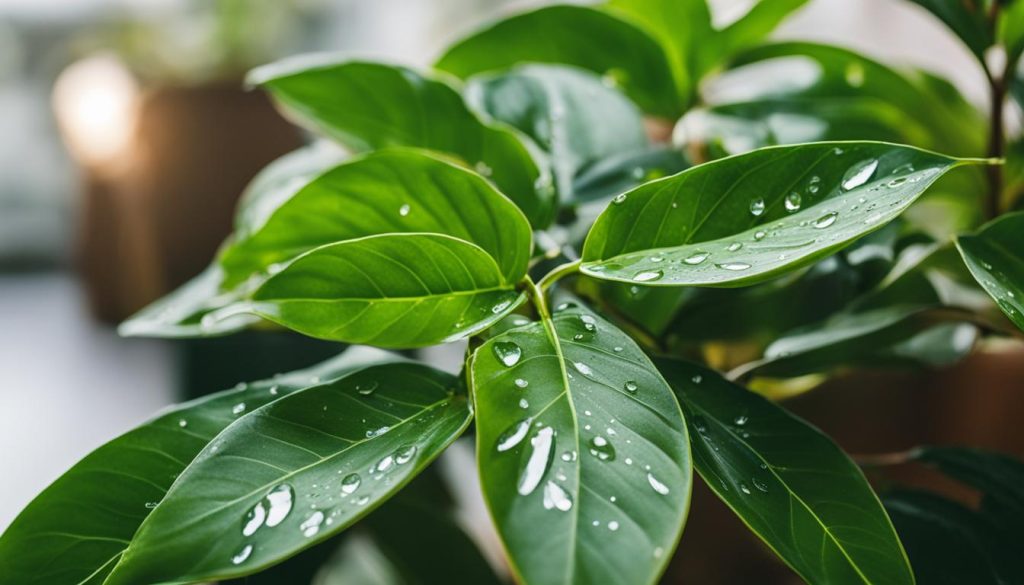
| Allow the top inch of soil to dry out between waterings | Schefflera |
|---|---|
| Light | Bright, indirect light |
| Watering | Allow top inch of soil to dry out between waterings |
| Humidity | Higher humidity levels |
| Temperature | 15℃ – 21℃ |
Monstera Care Tips
When it comes to caring for Monstera plants, also known as Swiss cheese plants, there are a few key factors to keep in mind to ensure their health and happiness. Monstera plants thrive in bright, indirect light, so it’s best to place them near a window where they can receive plenty of filtered sunlight. Avoid direct sunlight, as it can scorch their delicate leaves.
Watering is another important aspect of Monstera care. These tropical house plants prefer to be kept consistently moist, but not overly saturated. Allow the top inch or two of soil to dry out before watering again. This will prevent waterlogged roots and the risk of root rot. It’s important to note that Monstera plants are more tolerant of underwatering than overwatering.
Humidity for Monstera Plants
As tropical plants, Monstera plants thrive in high-humidity environments. If the air in your home is dry, you can increase humidity around your Monstera plant by misting its leaves with water or placing a tray filled with water near the plant. Another effective method is to use a humidifier to maintain the optimal humidity level of around 60-70%. This will help prevent dryness and leaf browning.
Temperature and Pruning
Monstera plants prefer temperatures between 18℃ and 30℃. They can tolerate slightly cooler temperatures, but it’s best to keep them away from drafts or extreme temperature fluctuations. Regular pruning is also recommended to maintain the plant’s shape and encourage healthy growth. Remove any yellowing or damaged leaves, as well as any aerial roots that may appear.
| Aspect | Monstera Care Tips |
|---|---|
| Lighting | Bright, indirect light; avoid direct sunlight |
| Watering | Keep soil consistently moist; allow top inch or two to dry out between waterings |
| Humidity | High humidity preferred; mist leaves or use a humidifier in dry environments |
| Temperature | Optimal temperature range: 18℃ to 30℃ |
| Pruning | Regularly remove yellowing or damaged leaves and aerial roots |
Croton and Pothos Care Tips
Now let’s talk about caring for two easy-to-care-for tropical house plants: Croton and Pothos. These plants are perfect for beginners and can add a touch of tropical beauty to any space.
Croton plants come in a variety of stunning leaf shapes and colors, making them a vibrant addition to your home. They thrive in high-light to medium or low-light conditions, so you have flexibility in placing them around your space. Remember to keep the soil moist but not constantly wet, and provide them with high humidity to keep their foliage looking lush.
Pothos plants, on the other hand, are great starter plants for those new to indoor gardening. They are incredibly versatile and can thrive in a variety of light conditions, making them perfect for any corner of your home. Allow the soil to dry out completely between waterings to prevent overwatering, and note that Pothos plants are tolerant of low humidity.
Both Croton and Pothos plants prefer temperatures between 18℃ and 24℃, so make sure to keep them in a comfortable environment. With a little care and attention, these tropical house plants will reward you with their stunning foliage and easy maintenance.
FAQ
Are tropical house plants difficult to care for?
While some tropical house plants may require extra care, many are actually quite easy to care for. With the right knowledge and attention to their individual needs, tropical house plants can thrive in your home.
Can Dieffenbachia (Dumb Cane) be harmful to pets and children?
Dieffenbachia is not highly poisonous, but it can cause swelling if ingested by pets or children. It’s important to keep Dieffenbachia out of reach and educate others about its potential effects.
How much light do Bromeliads need?
Bromeliads have different light requirements, ranging from bright, indirect sunlight to constant shade. It’s important to consider the specific variety of Bromeliad you have and provide the appropriate light conditions.
What type of light is best for Philodendron plants?
Philodendron plants prefer dappled, bright light to mimic the light conditions found under a tropical canopy. They should be placed in a location that provides filtered sunlight throughout the day.
How often should Ficus plants be watered?
Ficus plants are sensitive to overwatering, so it’s important to check the soil moisture before watering. They should be watered when the top inch of soil feels dry to the touch.
Are Alocasia plants suitable for beginners?
Alocasia plants require extra care and are better suited for experienced plant owners. They have unique foliage but can be challenging to care for, so it’s important to ensure you can provide the specific conditions they need.
How often should I water Anthurium plants?
Anthurium plants should be watered when the top inch of soil feels dry. It’s important to avoid overwatering, as they prefer well-draining soil and can be susceptible to root rot.
What type of light is best for Schefflera plants?
Schefflera plants prefer bright, indirect light. They can tolerate lower light conditions but may become leggy. It’s important to find a balance and provide them with adequate light for healthy growth.
How often should I water Monstera plants?
Monstera plants should be watered once a week, allowing the soil to dry out completely between waterings. Overwatering can lead to root rot, so it’s important to ensure the soil has proper drainage.
Are Croton and Pothos plants suitable for beginners?
Yes, both Croton and Pothos plants are easy-to-care-for tropical house plants and are great choices for beginners. They have different light and watering requirements, but overall, they are relatively low-maintenance.
- 20+ Chic Boho Bedroom Ideas for a Cozy and Stylish Retreat - June 20, 2024
- 12+ Modern Boho Living Room Ideas to Create a Unique Oasis - June 10, 2024
- 10 Stunning Canopy Bed Ideas for a Dreamy Escape - May 16, 2024

